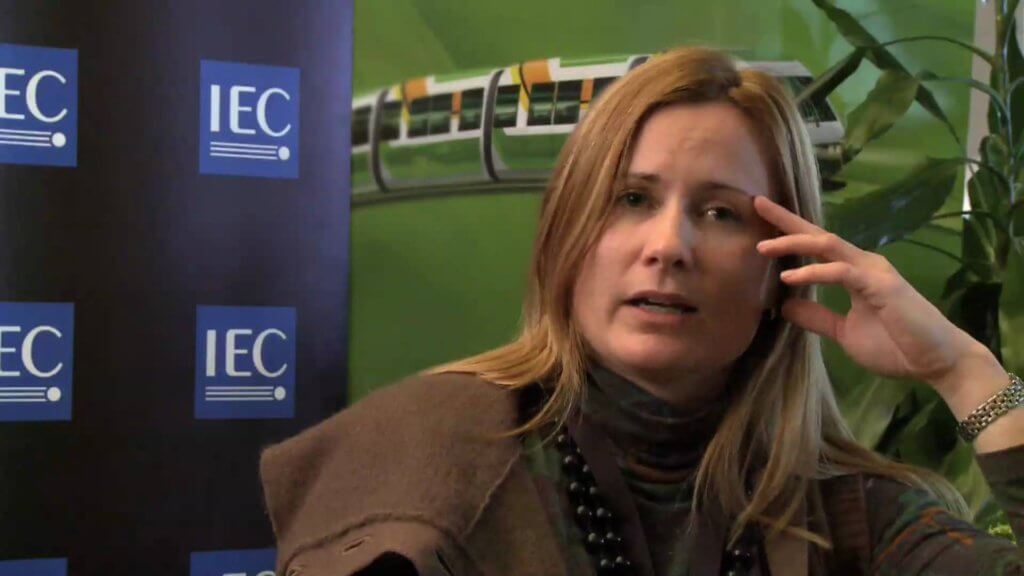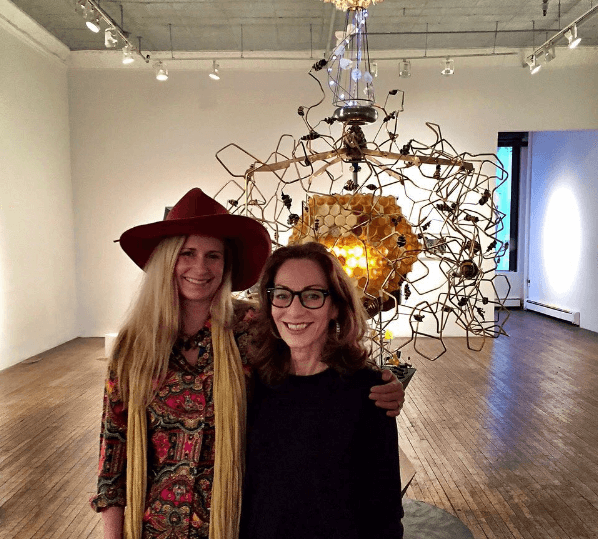I first knew about Kelly Heaton through SciArt Magazine, an online magazine that explores the intersection of Art, Science, and Technology. When I stumbled on her work, I was immediately drawn to her usual technique of using Electricity to develop her Art form and pass across her message which is steeped in Psychology and the human nature. Her work is heavily laden with Metaphors and as you know, I am a deep lover of Metaphors. I just kept wondering how she got to this stage of combining Engineering with Art in such depth, so I went stalking, found her email address and sent her a mail about Career Migrants and what we are hoping to achieve with the series, and she replied! We set up a virtual date and had a very stimulating conversation. I must say, my soul is thankful for that conversation, it was such a pure, honest and electrifying conversation – from struggling as a traditional Artist to entering the world of Engineering and coming forth as an Artist born of intertwined worlds. 
Here’s a bio of Kelly, so you get a feel of who she is before you dive into the interview.
Kelly Heaton (b. 1972) is an American artist who examines the impact of electronics on modern civilization. Trained in art and science, Heaton uses her engineering background to explore psychology, the human-machine relationship, and our increasing separation from nature. Her early work contains functional circuits that give a “machine life” dimension to her art by reacting to the viewer with sound, light, and movement. Her recent practice is characterized by layers of imagery that portray human identity in the digital age. She combines high-tech and Luddite themes, as well as electronic and static media, to offer her audience a deeper understanding of contemporary culture. Heaton’s work also reminds us to stay connected with nature lest our dependence on technology be our demise.
Using elements of electronic circuitry, the artist, and scientist, Kelly Heaton tries to mirror the process of the creation of life. Through these works, as well as through more traditional practices that incorporate kinetic sculpture, time-based narrative, and spirituality, she combines the natural and manmade—like handmade electronic fireflies resting on harvested tree branches—to raise questions of ownership, creation, and the very essence of life. Kelly also has a Perfumery, she is a self-taught Perfumer.
After a couple of minutes fiddling with the Skype interface amidst the gamble of an unstable internet, we finally got talking and dived right into a very robust conversation about Art, Outsider Artists, Science and Electrical Engineering.
For Creative Girls: It’s interesting that you are a combination of many fields. I’ve always been interested in the culmination of different fields in people. How we are not one single polarity, but a smorgasbord of sorts.
This is great, I share a lot of your interests. Maybe partly because I’m located in a rural area. I studied my undergraduate degree at Yale University in Connecticut.
Let me give you my life story in a nutshell – I grew up in North Carolina, a pretty rural area, so as a child I was always in the woods, I was in Nature. And so I was a combination of Art and then Naturalist, I guess. So from early in my childhood, that was what I was always drawn to and when I went to college, I really wanted to study Art and I had heard that Yale University has a great Art program but it turns out that the Art program is at the graduate level…?
Oh Wow!
Kelly Heaton: Yes, I mean, you know I should have done my research more but I was a stupid 18-year-old. Hahaha. And I got frustrated because the Art classes at Yale were pretty traditional and more of how to paint a landscape. And at that time I was already interested in Art & Science, but I guess I didn’t know it. I just started having visions where I wanted to make a painting but I also wanted to add a more philosophical side – my kind of philosophical and analytical perception of reality merged with my visual perception. And that really started growing in me when I was 18 years old, & no one understood what I was talking about and there wasn’t any support from my Professors for my experimentations because they wanted me to paint like Rembrandt or Michelangelo.
So it was kind of a struggle and a drag. Any woman who combines Art with Science will tell you this – when you first explore the intersection, you fail over and over again, because you are trying to do something that has never been done before, so there’s almost no reference point. And so the only way you can progress is to make your own reference point. You have to then try something, look at it and say, is that successful?
And then there’s another complicated aspect which is true of any contemporary Art, which is this – when something is brand new, often times, some people or most people don’t understand it. So, there’s the difficult side which is that you have to be your own critic because if you believe that the results you are getting are on the right path, you have to just ignore what people tell you and keep going. I get feedback from people saying “I don’t understand what you’re doing”, “I can’t relate to what you are doing”
Its funny Engineers tend to be drawn to me and get fascinated by me, typically men, actually. Because they’re like “I recognize some of these things that you’re doing. I don’t understand Art generally, but it’s cool.” sort of thing, but it never really goes beyond that. They tend to be interested in the Engineering aspect – “Oh look, there’s a transistor. oh look, she’s designing a circuit.” So, they get kind of nerdy about it – “you should make it more complicated.”
And then on the Art side, I’ve been called an Outsider Artist. Does that mean anything to you?
Yeah, I kinda understand that. But, you should elaborate more. Artists are generally looked at as outsiders.
Kelly Heaton: Well, actually only in the past 10 years has there been a Contemporary focus on Art coming out of the African continent. Before that Artists creating work in Africa were kind of regarded as Outsider-outsider. People perceive the Art that’s coming from places they don’t understand with a very primitive view. So, there’s a meta-nation of people who are working in Art & Science, and the Art world totally does not understand us. There are just a few people, here and there that are really good at what they do and they are very social, very eloquent. They often live in places like New York or LA, or San Francisco and they’ve broken through to get attention for the combination of Art & Science, but sometimes it’s in a superficial way. I don’t know if you know the work of Cory Arcangel. He got really popular in the Art world for a while, his work combined Art and Technology, but it was more like he knew the right people and I don’t know if they even understood or cared about what he was doing. He just kind of became cool. You get what I mean?
Yeah, you know that’s a problem! A lot of people just see Art as this abstract thing that cannot be applied to the real world. For example, you still find people say things like, “why would my child go study Art?” Because they can’t seem to find how to apply it in other fields and so they have a problem with it.
They think it’s ‘this cool thing that you guys do’. To them, it’s just cool.
It’s a problem here too. My parents felt that I needed to get a paying job. The Science – Art intersection is an Outsider area, if you live in a rural part, you’re an outsider artist, if you add a cultural perspective that people didn’t know about, you’ll be viewed as an outsider artist. There are so many layers of this. I think the outsider-artist designation is really more of a dismissal.
To finish up this trajectory – So when I was an undergraduate and I was frustrated with the Art program. I ended up designing my own major in the intersection of ecology and urban planning. I was looking at how you can design human societies that embrace nature, yet people can live and work, and be profitable. My thesis project took me to Honduras and I lived in Honduras for 3 months, working on an ecotourism project there which was a very good learning experience but a total disaster from a result perspective, because you know big money always seems to win these battles. There was a multinational corporation from Mexico and there was no way we were going to win.
After that, I couldn’t get a job. This was in the 90s and there was no money for people who were trying to do ecologically responsible developments. And I ended up in a Software Training company for a while, and then my first marriage fell apart. So I started asking myself, what can I do to make money? And I decided I’d be a Veterinarian – I grew up in nature and I love animals, so I decided to do that. I started studying Immunology and applied for a Ph.D. program scholarships, so they would pay for my education. Yes, I always apply for Grants.
So, I was studying and applying for Scholarships so I could go to Veterinary college and then my marriage fell apart, and I was so devastated, I deferred Veterinary college and I applied for another grant to go to Art school and I got it. And that grant was really interesting because this was in 1996. The grant that I wrote/got was to combine Art & Science and it worked! I think it’s pretty cool that in 1996, somebody gave me money to do that.
So, I went to the school of the Museum of Fine Arts in Boston and I was there for a year, but the same thing happened again where I was in this community of Artists who had no education on Technology or Science, they could care less. All they wanted to do was go paint a canvas and I kept wondering and thinking “this isn’t what I want to do”
Then, I got really lucky, I met a guy who was a graduate of MIT and he said “You should really go there. There’s this place called the Media Lab” and I was like “You’ve got to be kidding me. I don’t have enough of a background in Technology to do that.” I didn’t know how to build a circuit. I didn’t know how to program computers, I didn’t know any of that. But he introduced me to a man named Michael Hawley, who just by chance was looking to add an Artist to his research team because he wanted to add creativity as part of the Engineering and I remember his precise words, he said to me when I told him, I don’t know any of the Engineering stuff “As long as you are not allergic to Technology, you’ll be fine.” So, I got into MIT without applying.
Wow! That is so interesting. What a Journey! And MIT Media Lab seems like the kind of place Tech and Art can combine to birth something grand.
Yeah, it is the kind of place. I mean, if you can do something there, I’d say go for it. You would absolutely love it. I ended up doing 2 years at MIT. When I was at MIT, it felt like taking an 8-year-old child and sending them through college. Seriously! The highest level of Maths that I took in high school is Calculus and I wasn’t good at it, and suddenly I was thrust into these classes where I had to write code. I had never written a line of code in my life! It was surreal. I was stressed out and overwhelmed, it’s like if you showed up in Japan and you don’t speak Japanese, but you have to be a Writer in Japanese. It was like that. So, I survived MIT by basically begging guys to help me do my homework. I’m not proud to say that but that really is what I did until I started to figure out how it worked. So, that was how I learned Programming and then Electrical Engineering took much longer and that’s the thing that I use most.
Yeah, it’s amazing how you work with Electricity. How did you get interested in it and decide that your Art would take the Electrical shape?
It took me probably 15 years to really understand that consciously. I was drawn to it, but in the early stages, I didn’t understand why. So, I was initially interested in computer-animated toys like Furby by Sherry Turkle – who is a Psychologist that studies the psychological effect of technology on children and childhood development. So if you look at some of my earlier work like Reflection Loop, Live Pelt, you’ll see that I started my exploration by looking at how Technology was affecting human psychology. So I had some early success in my career because of that, which was great. I got a grant from Creative Capital in 2002, and I had several shows of my early work, where I was looking at these computerized toys and they affect human psychology. But I got frustrated because my audience really focused on the toy, and on the robot, and on the idea of the fetish. So they didn’t get the Psychology and consciousness aspect that was really my focus. This is where I started to get clear about my interest in Electricity. I started working on a new project, The Parallel Series.
After Live Pelt, I was broke and depressed. I had had an earlier success, with people writing about me, but I was making no money. All the money that I got from grants, I spent on my Art. I was living in a bad neighborhood and it was just really hard. And my Parents were still insisting that I get a job. So, it was kinda tough. I guess I thought money was a sign of success.
But back to MIT and using Electricity, I met a man at the MIT Media Lab (At the Media Lab, all the funding comes through corporate sponsors, so companies pay a lot of money to come see what people are doing at the Media Lab. To see it and to have the right to use the Technology. So sponsors periodically come check out students research) who worked for the pharmaceutical company, Roche. So he invited me to come to Switzerland and work part-time for him. And the money I was being paid was good enough for me to live in Switzerland, work part-time inventing products for Diabetes care and work on my Art. So I moved to Switzerland for 5 years and was working in Diabetes care as an inventor, I invented methods of visualizing glucose data for people with diabetes, so they had a better understanding of how their blood sugar was fluctuating.
That makes a lot of sense and sounds very interesting, inventing methods of visualizing glucose data!
Yes, it was actually very interesting and really cool. I had my name on several patents which I’m very proud of! So, I worked for Roche and during that time I developed an Art Project called The Parallel Series, cultivating my walk with Electricity. And what I really wanted to do with The Parallel Series was to really present my audience with this idea of electricity as the substance of life and I really wanted people to ask themselves, “if I’m looking at an electronic circuit that is man-made or in this case, woman-made, how is that different from a living biological organism and what is the magical spark of life?” When does a computer become a life form, is it a life form, just a different one? Because if you think about viruses, for example, are they alive? Or if you look at very simple organisms like Amoeba, for example, people can write software to simulate the behavior of an amoeba and now we can synthesize them in a laboratory. So, are they alive and what is that magical distinction between a God-made living organism, in that spiritual religious concept of the spark of life, and something that is artificial like a robot, a circuit.
The more I tinkered with electricity, the more I made circuits that simulated life, the more I really got fascinated by this question of what it means to be alive and is my body just a giant circuit. And I think the answer is yes!
At the same time, I’m a Christian and a deeply spiritual person, so I believe there is more.
I’m constantly looking at what are psychic phenomenon and what is our experience of God or the soul? And can that also be explained like Electromagnetism or like are there other aspects of electricity in reality that we don’t understand yet? Because in computer science, so many people are trying to develop Artificial Intelligence and they’re just focusing on logic, so what about emotional and spiritual intelligence? I personally believe that emotional and spiritual intelligence are more important than logic, I think logic is the tip of the iceberg.
Yes, you are correct. Most of our decisions are not black and white logical.
Exactly! Think about it. All day long, look at the decisions that you make. How could you possibly think that they are logical and explain them from logic? Your subconscious is controlling so much of what you’re doing.
I think the issue is that because the logical way is the simplest way to go for starters to unravel problems, from the Artificial Intelligence point of view, so it just makes sense to say ‘let’s do logical things’. Once you start saying you want to go into Emotional Intelligence etc, you’ve lost a lot of Scientists, they don’t know how to navigate that. So, for them ‘logical’ is a much more straightforward way to approach things, so they approach that because we’ve not found an answer to approaching emotional things. And it’s funny because most of what guides us are emotional.
Yeah, I understand what you mean, Marvin Minsky wrote a book about Emotional Intelligence and all of these before he died, you should check it out. But, basically, you see how my fascination with electricity is formed because I’m trying to understand how these (Engineering, Spirituality, Art) work together.
So, when I exhibited the Parallel Series, people thought it was cool and neat because they saw that I reproduced the sound of an insect using a Circuit, but they still didn’t see what I was seeing. So the next series I created was Pollination – and I kind of went back to my concern about the destruction of nature and how fast this destruction is happening, it’s really bothering me. It’s a serious problem for the future generations of people on earth. Our survival is at risk based on what we’re doing right now.
So, I got really interested in the Honey Bee as a metaphor for what is happening to nature and mankind’s relationship to nature. And because I also love this idea of Pollination and cross-pollination between Art, Science, Technology, and Spirituality. I, therefore, made an effort in Pollination to make electric parts like characters. They became bigger and I sort of anthropomorphized them, because I wanted people to see them as almost becoming human or lifelike. So nobody really understood that too. Hahaha.
Ever since then, I’ve been working really hard to try to represent all of these things that I’ve been talking about merging all of these parts (electricity, technology, biology, nature, soul, art, spirituality).
Right now, I’m working on two projects: The Anthropocene – addressing the environment and The Human Electric – portraits of people where I intersect them with electronics, to try and create a new psychological portrait of who we are. But, I’m not sure I’ve figured out how to create images that communicate my message, I don’t know if I’m ahead of my time. So, I’ve really been struggling with all of that and then the financial implication of it is also a problem.
So, when people like you contact me, it’s so rewarding. To be able to have a conversation with someone who understands my work and what I’m doing is so rewarding. Think about this conversation and trying to explain it to somebody who lived a hundred years ago, it’s mind-blowing, it’s almost impossible to think about in that age! How would you even explain a woman combining Art, Tech & Science to someone in that time?
Are you like Kelly Heaton? Did you move from Arts to STEM or from one field of study to another new one entirely? We’d love to interview you. Please fill this short Career Migrants form below, so we can reach out to you and interview you.
You should follow Kelly Heaton on her Website, Twitter, Instagram and check out Perfume site.






